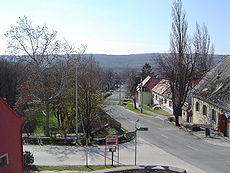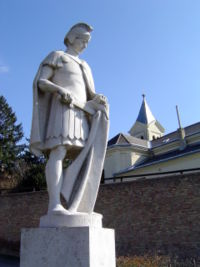
Pannonhalma
Encyclopedia

Hungary
Hungary , officially the Republic of Hungary , is a landlocked country in Central Europe. It is situated in the Carpathian Basin and is bordered by Slovakia to the north, Ukraine and Romania to the east, Serbia and Croatia to the south, Slovenia to the southwest and Austria to the west. The...
, in Győr-Moson-Sopron
Gyor-Moson-Sopron
Győr-Moson-Sopron is the name of an administrative county in north-western Hungary, on the border with Slovakia and Austria. It shares borders with the Hungarian counties Komárom-Esztergom, Veszprém and Vas. The capital of Győr-Moson-Sopron county is Győr...
county with approximately 4,000 inhabitants. It is about 20 km (12 mi) from Győr
Gyor
-Climate:-Main sights:The ancient core of the city is Káptalan Hill at the confluence of three rivers: the Danube, Rába and Rábca. Püspökvár, the residence of Győr’s bishops can be easily recognised by its incomplete tower. Győr’s oldest buildings are the 13th-century dwelling tower and the...
. Archduke Otto Habsburg's heart is kept at the Pannonhalma Archabbey
Pannonhalma Archabbey
The Benedictine Pannonhalma Archabbey is the most notable landmark in Pannonhalma and one of the oldest historical monuments in Hungary, founded in the year 996. It is located near the town, on top of a hill...
, while his body was laid at the Capuchin Crypt in the old Imperial capital of Vienna
Vienna
Vienna is the capital and largest city of the Republic of Austria and one of the nine states of Austria. Vienna is Austria's primary city, with a population of about 1.723 million , and is by far the largest city in Austria, as well as its cultural, economic, and political centre...
.
History

Pannonhalma Archabbey
The Benedictine Pannonhalma Archabbey is the most notable landmark in Pannonhalma and one of the oldest historical monuments in Hungary, founded in the year 996. It is located near the town, on top of a hill...
and the Benedictine Secondary School
Benedictine Secondary School, Pannonhalma
The Benedictine Secondary School of Pannonhalma is an independent Roman Catholic boarding school for boys, one of the most distinguished secondary schools in Hungary, led by and situated next to the thousand-year-old Pannonhalma Benedictine Archabbey above Pannonhalma, Győr-Moson-Sopron...
, which are situated above the village, on Szent Marton Hill. The hill itself is still known by this ancient name and the name 'Pannonhalma' was introduced as part of the Hungarian language reforms in the nineteenth century. The association with Saint Martin ('Szent Márton' in Hungarian) derives from a belief that Martin of Tours
Martin of Tours
Martin of Tours was a Bishop of Tours whose shrine became a famous stopping-point for pilgrims on the road to Santiago de Compostela. Around his name much legendary material accrued, and he has become one of the most familiar and recognizable Christian saints...
was born here, though others believe he was born in nearby Szombathely
Szombathely
Szombathely is the 10th largest city in Hungary. It is the administrative centre of Vas county in the west of the country, located near the border with Austria...
.
There is a small statue in the town at the crossroads under the abbey which shows the saint as a Roman soldier, cutting his cloak according to the legend associated with him. The wall behind this is part of the original fortifications which were built in 1569 as a result of incursions into Western Hungary by the Ottoman Turks
Ottoman Turks
The Ottoman Turks were the Turkish-speaking population of the Ottoman Empire who formed the base of the state's military and ruling classes. Reliable information about the early history of Ottoman Turks is scarce, but they take their Turkish name, Osmanlı , from the house of Osman I The Ottoman...
. The area remained a moving frontier between the Islamic Ottoman empire and the Christian west for the following 140 years and the town suffered considerable damage during this time.
From at least the nineteenth century, Szent Marton had a significant Jewish community. They played an important role in the commerce of village, as it was then, until the latter years of World War II
World War II
World War II, or the Second World War , was a global conflict lasting from 1939 to 1945, involving most of the world's nations—including all of the great powers—eventually forming two opposing military alliances: the Allies and the Axis...
. In 1944, the remaining Jewish families were rounded up and sent to extermination camps. A small synagogue
Synagogue
A synagogue is a Jewish house of prayer. This use of the Greek term synagogue originates in the Septuagint where it sometimes translates the Hebrew word for assembly, kahal...
, built in the late 1800s, remains on the main street, though it is no longer in use. The building is in the process of being restored and a monument has been constructed on the street in front of it. Some dozens of Jews were protected in the abbey when it was taken under control of the International Red Cross in October 1944, along with 3,000 other refugees, many of them children, thanks to the efforts of a Swiss national, Eduard Benedek Brunschweiler
Eduard Benedek Brunschweiler
Eduard Benedek Brunschweiler was a Swiss national who was appointed by the International Committee of the Red Cross to manage the Benedictine Archabbey of Pannonhalma on their behalf, during the final months of the German occupation, towards the end of the Second World War.In early 1944, Archabbot...
. The IRC was expelled from Pannonhalma by the Red Army in April 1945.
In 1996, parts of the town were included in UNESCO
UNESCO
The United Nations Educational, Scientific and Cultural Organization is a specialized agency of the United Nations...
's demarcation of the Abbey as a World Heritage Site. Four years later, the village of Pannonhalma was officially granted 'town' status.
Amenities
Apart from local food and hardware stores, the town also has a number of coffee houses and pubs, wine cellars and two restaurants. There are two in the centre by a church and lower by a supermarket (Coop). By the church are a wine cellar, restaurants, coffee house, pubs, bank ATM, and post office. By the supermarket are stores, family doctors, dentist, and pediatrician, pharmacy, elementary school, ambulance, and police station, and a small tourist office.Transport
There are regular commuter trains and local bus services to and from Győr. There are 4 bus direct to the archabbey a day. The railway station is situated at the lower end of the town at the bottom of a slope which rises more steeply at its end as it reaches the archabbey at the top of Szent Marton Hill, a distance of about 1.5 km. Local bus services stop by church, in the top part of the town, closer to the archabbey, and on Highway 82, close to the gas station, about 1 km from the town centre. Over 100,000 tourists visit Pannonhalma each year, though most see little of the town itself. Tour buses normally stop at the car park near the modern reception centre towards the top of the hill, where there is good access for disabled visitors. There is a restaurant and small gift shop next to this car park, and it has good views over the surrounding countryside.Wine
There are a number of arable farms in the area and many smallholders still grow grapes, often to make their own wineWine
Wine is an alcoholic beverage, made of fermented fruit juice, usually from grapes. The natural chemical balance of grapes lets them ferment without the addition of sugars, acids, enzymes, or other nutrients. Grape wine is produced by fermenting crushed grapes using various types of yeast. Yeast...
. Many gardens built on a slope include a small wine cellar excavated out of the soft sandstone.
The Pannonhalma-Sokoró wine region consists of 630 hectare
Hectare
The hectare is a metric unit of area defined as 10,000 square metres , and primarily used in the measurement of land. In 1795, when the metric system was introduced, the are was defined as being 100 square metres and the hectare was thus 100 ares or 1/100 km2...
s and the main white grape varieties grown here are Pinot Gris
Pinot Gris
Pinot gris is a white wine grape variety of the species Vitis vinifera. Thought to be a mutant clone of the Pinot noir grape, it normally has a grayish-blue fruit, accounting for its name but the grape can have a brownish pink to black and even white appearance...
, Chardonnay
Chardonnay
Chardonnay is a green-skinned grape variety used to make white wine. It is originated from the Burgundy wine region of eastern France but is now grown wherever wine is produced, from England to New Zealand...
, Rhine and Italian Riesling
Riesling
Riesling is a white grape variety which originated in the Rhine region of Germany. Riesling is an aromatic grape variety displaying flowery, almost perfumed, aromas as well as high acidity. It is used to make dry, semi-sweet, sweet and sparkling white wines. Riesling wines are usually varietally...
, Királyleányka, and Traminer (Gewürztraminer
Gewürztraminer
Gewürztraminer is an aromatic wine grape variety that performs best in cooler climates. It is sometimes referred to colloquially as Gewürz, and in French it is written '...
). An Ice wine
Ice wine
Ice wine is a type of dessert wine produced from grapes that have been frozen while still on the vine. The sugars and other dissolved solids do not freeze, but the water does, allowing a more concentrated grape must to be pressed from the frozen grapes, resulting in a smaller amount of more...
variety is also produced from Riesling. There are fewer red wines in this area; the most widespread is Kékfrankos.

